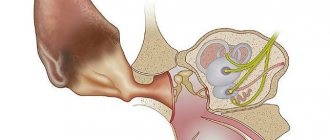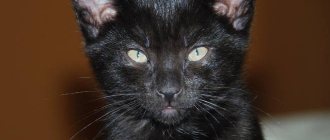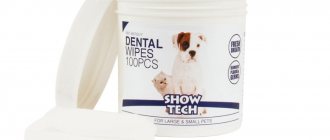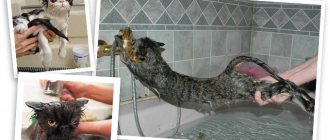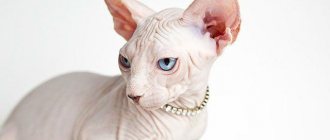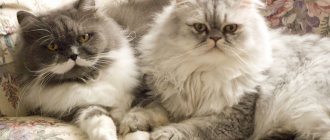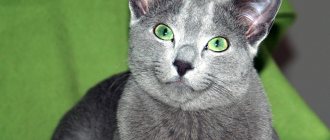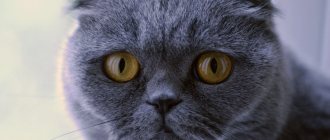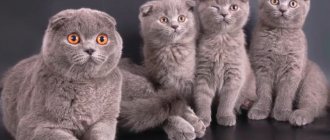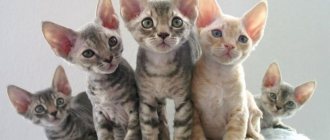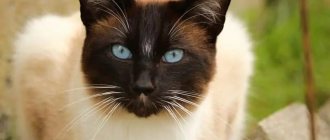Representatives of felines have acute hearing and can hear the slightest movement or movement of the victim while living in their natural environment. With its help, cats are well oriented in space in an unfamiliar area and can accurately determine the distance to the sound source and its direction.
If a cat's ear canal becomes dirty, the animal experiences significant discomfort, loses a number of natural abilities, and becomes more vulnerable. Dirt can provoke the formation of sulfur plugs or cause an inflammatory process. Today we will talk in detail about whether cats can have their ears cleaned, how to do it correctly, what a healthy ear looks like, and in what situations it is necessary to contact a veterinarian.
How often to check
Ideally, a preventive examination of the pet’s ear should be carried out every day or once a week, accustoming it to this procedure from early childhood. This is easy to do; while your pet is lying in your arms or carelessly playing with his favorite toy, carefully and carefully bend the edge of the ear and look inside. If the animal is healthy, the shell should be a soft pink color, there should be no dirt in it, and minor sulfur deposits are allowed.
Some cat breeds require more frequent and thorough preventive examinations due to the anatomical features of the structure of the auricle. Animals with large ears get their ears dirty faster than usual; these breeds include:
- Maine Coons;
- Abyssinian breed;
- Devon Rex;
- Somali cats;
- Scottish Folds and others.
Cats that do not have fur inside the ear canal are susceptible to active production of wax to protect against dust and dirt getting inside.
Devon Rex and other breeds with short or no hair need regular ear hygiene.
Features of the structure of the animal's auricle
A cat’s ear, like a person’s, consists of 3 sections:
- External: a funnel-shaped auricle, covered on the inside with a small amount of guard hairs and on the outside with hair, and the external auditory canal.
- Middle: includes the eardrum and the bony tympanic cavity, where the 3 auditory ossicles are located. They play one of the leading roles in the perception of sound.
- Internal: hollow bone formation in the temporal bone, the most complex section. It contains the receptor channels of hearing and the vestibular apparatus.
In humans, the auditory canal is straight and short, but in cats it bends and runs slightly at an angle. Due to ignorance of this feature, during cleaning you can create a sulfur plug that will block the passage.
The cat's ear can detect vibrations from 20 to 100,000 Hz. With the help of muscles and cartilage, the auricle rotates in different directions, which allows you to accurately determine the source of sound. All this makes animals excellent hunters.
Earwax formation and its role in the ear canal
The formation of sulfur is not a pathology, but a natural process. The ear secretion performs several important functions:
- lubricates and moisturizes the skin in the ear canal;
- provides protection against bacteria and fungi;
- prevents the ingress of dust, hair and skin particles, and insects.
All debris that enters the ear, thanks to the sulfur, clumps and comes out naturally. The cat brushes off the residue while washing.
If the production of wax is impaired, pathogenic bacteria easily enter the ear, causing animals to develop:
- otitis;
- dermatitis;
- otomycosis (fungal infection) and other diseases.
In healthy animals, earwax has a paste-like consistency, is light brown in color, and has virtually no odor. Changes in color, thickness, or the appearance of an unpleasant odor indicate the onset of the disease.
Cleaning a cat's ears - what you need
How to clean a cat's ears and how long does it take? For hygienic cleaning you need 10-15 minutes of time, a little patience, and also:
- soft discs or cotton swabs;
- cotton swabs with a limiter for children;
- special products for gentle, safe cleaning, sold in specialized veterinary stores.
Cotton pads or swabs are used to pre-treat the sink and evacuate large dirt and dust; with the help of cotton swabs, it is possible to capture sulfur and dirt.
To reduce the time of hygiene measures, veterinarians recommend using special lotions.
Their action is aimed at softening sulfur deposits and facilitating their evacuation. Lotions and drops for cleaning ears do not irritate delicate skin, have a pronounced antibacterial effect, do not cause an allergic reaction, and effectively eliminate unpleasant odors.
Schedule of antiparasitic treatments and vaccinations for Scottish Fold cats
The first vaccinations for Scottish Fold kittens are given in the nursery at the age of 2 months. In the future, throughout life, a simple rule applies - no matter how old a cat is, the number of times it must be vaccinated with mandatory drugs. And antiparasitic treatments are carried out 2 times more often.
Important! Sometimes poor appetite and apathy are alarming signs and indicate the presence of an infection in the animal’s body. Therefore, a deterioration in the pet’s general health may be a reason to postpone the vaccination of the Scottish Fold cat.
How to clean a cat's ears at home without causing harm
In order not to cause emotional and physical trauma to the cat, you need to act carefully and slowly. You cannot hold an animal by force, use force, and, especially, scold it.
In addition, it is strictly forbidden to use ordinary hygiene sticks and, even more so, to clean the cat’s ears with matches or tweezers wrapped in cotton wool. This can lead to the following consequences:
- the cat may involuntarily jerk its head, which will lead to injury to the delicate tissue of the ear;
- the wound cotton wool may accidentally end up inside the ear canal;
- the hard end of a match or tweezers can scratch the passage and cause infection of the wound.
It should be noted that the epithelium of the pet’s ear canal is very delicate and can easily be scratched due to careless movements or too deep penetration of the stick. If its integrity is damaged, there is a risk of disrupting the natural ventilation of the hearing organ. As a result, humidity levels increase, and in such an environment the risk of developing a bacterial or fungal infection is high.
Feeding and caring for the Scottish Fold cat
The Scottish cat is unpretentious in choosing food, but this does not mean that it needs to be given everything. To properly organize the process of feeding your pet, you will need not only high-quality products, but also convenient utensils.
Bowls for food and water
Bowls and drinking bowls for cats can be plastic, glass (ceramic) and metal. Each of these materials has its own advantages and disadvantages:
- Plastic utensils are the cheapest. But it quickly fails, since the material is subject to cracking, the scratched surface is difficult to clean from dirt, and particles of old food remain in microcracks.
- Metal utensils are more expensive, but their consumer properties are much higher.
- Ceramics and glass are a middle option between bad and expensive. Most often, these bowls are used to organize the feeding of Scottish Fold kittens and adult cats.
The dish should be wide, shallow and stable. Starting from 2 months, Scottish Folds eat on their own and get used to certain conditions. Most often, during this period of life, the kitten lives in a nursery near the mother cat, and all reflexes are formed there. Therefore, you should ask the breeder what bowls and drinking bowls he uses in order to choose the usual dishes for the baby.
Important! Scottish cats are prone to urinary tract diseases such as idiopathic cystitis and urolithiasis. Therefore, the owner must provide the animal with free access to fresh water. You can equip a special fountain for your pet and place drinking bowls in different places.
Natural nutrition
Most often, Scottish Fold cats begin to be fed with natural products during childhood. This is completely justified due to the ability to control the quality of food. True, the other side of the coin is the requirement to independently create a balanced menu and take into account the energy value of products. Until 2-3 months, kittens are kept in a nursery, where they learn to eat on their own and prepare for adult life. It is best if this cycle is not disrupted, and the babies go to a new home at the age of 10-12 weeks.
Rules for feeding Scottish kittens at home:
- A 3-month-old fold-eared kitten needs to be fed 6 times a day, the total weight of the daily diet is 150-180 g;
- at 4 months it is necessary to reduce the number of approaches to the bowl (1 less), and the total daily volume is increased to 250 g;
- By six months, Scottish Fold cats already eat no more than 4 times a day, then they are transferred to normal 2-3 meals a day.
For natural products, there is a universal method for calculating the daily weight of menu components - starting from 6 months, it is 1/10 of the cat’s weight:
- Up to 95% comes from products containing animal protein - this is the main food of cats in the wild, and it also predominates in the diet of domestic animals (lean meat and offal).
- An adult cat’s body does not digest milk, so it is preferable to give your pet fermented milk products - sour cream, fermented baked milk, kefir, yogurt.
- Once a week, a chicken egg - it is called the ideal protein for building the body.
- River or sea fish (boiled) are introduced into the cat’s menu at the age of 5 months.
- Vegetables, fruits and cereals are mixed with meat - there is fiber, valuable coarse fiber and many other nutrients. But such products cannot replace protein and be the main food in the diet of Scottish Folds.
Important! In order not to calculate the nutritional value of each serving, it is recommended to make preparations and keep a weekly record of products. The main thing is to maintain the overall balance of nutrients that the cat receives.
Industrial feed
It is advisable to switch Scottish cats over 1 year of age to wet or dry commercial food. It’s easier and faster, and manufacturers take care of the proportions of useful components. On the packaging they usually indicate the serving size according to the age and weight of the pet.
Canned cat food is almost no different from natural food in terms of nutrient content and moisture content.
Important! When switching from natural food to dry food, you need to slightly soak the granules with water so that the cat’s stomach gradually gets used to the new food.
Combined nutrition
The combination of two types of nutrition is most often used for older cats. Usually, products of the same brand are used for this - they have a common system for assessing the balance of nutrients and there is no fear that there will be an “overweight” in favor of one of the components.
Less often we talk about a combination of natural and industrial feeds. This is the most unsuitable option, since in this case it is impossible to correctly calculate the nutritional value of the diet.
Vitamins and minerals in the diet of the Scottish Fold cat
In the first months of life, Scottish Fold kittens receive the necessary vitamins and minerals through their mother's milk. After the pet switches to natural food, the owner will have to introduce useful components into the cat’s diet.
Vitamin complexes can be:
- general strengthening – contain elements necessary for healthy animals;
- specialized - the complex includes certain substances that are taken for specific diseases (such drugs are prescribed only by a veterinary specialist).
What should you not feed your Scottish Fold cat?
Many owners unfairly believe that their pet will never eat anything harmful on their own. This is a misconception - cats often eat everything, which causes serious eating disorders.
The category of “harmful” products includes:
- onions and garlic - destroy red blood cells, therefore in any form they are prohibited for cats;
- tomatoes and potatoes contain an alkaloid that can cause severe stomach pain;
- legumes are completely indigestible in the cat’s body and cause bloating and fermentation;
- mushrooms are toxic and often cause death;
- sugar is not fully absorbed and provokes a number of diseases;
- pasta is rich in fast carbohydrates and causes intestinal colic;
- baked goods and dough - bloating and gastrointestinal disorders.
Important! Nuts, persimmons, citrus fruits, grapes and raisins, duck and goose, pork, raw fish - each of these products has contraindications for inclusion in the diet of a Scottish fold cat. Therefore, it is better to completely abandon them and not risk your pet’s health.
Features of feeding a castrated or sterilized cat
If the owner does not plan to breed Scottish Fold straights (folds) and care for kittens up to 3 months of age, then sterilization or castration is the right way out. You just need to know that after surgery there may be side effects, for example, excess weight. Therefore, the pet should be switched to specialized food for castrated (sterilized) cats. If the Scotsman continues to gain weight, it is necessary to reconsider the animal’s diet and give him “hungry days” 2-3 times a month.
How to clean a cat's ears - preparation
Don't expect your cat to be happy about your desire to do ear hygiene. Cats are capricious animals and can show their character as a sign that they do not like the procedure. In order to develop a calm attitude towards cleaning, you should accustom the animal to hygiene measures, as well as to water procedures, from childhood.
Before you start cleaning, create a calm environment, make sure that the animal is fed, satisfied and in a good mood. Place your pet in your arms or place it comfortably on the floor, be gentle with her, stroke her periodically, speak gentle words, stop for a while, give your pet a break.
If the cat is nervous or worried, veterinarians advise to restrain it; for this you can use a thick terry towel. By leaving only the muzzle outside, you will prevent the kitten from scratching or biting itself, and will also protect it from mechanical injuries. If you can’t cope alone, you can use a second person, then one participant will be responsible for fixing, and the second will carefully clean the ears.
Grooming items and toys for Scottish Fold cats
It is recommended to purchase all accessories for keeping, feeding and caring for a Scottish Fold kitten at home in advance in order to create the most comfortable conditions for the baby’s adaptation to a new place.
Carrying – this accessory will be needed to deliver a fold-eared cat from the breeder to the apartment, and in the future all trips to the veterinarian or trips out of town will not be complete without it.
Plastic designs are very convenient and durable, but they take up a lot of space and only work well for long trips.
For city walks with a cat or trips into nature, a fabric carrier is sufficient - it is compact, easy to fold, but sometimes requires washing.
A bed and (or) a house, which can be made of different materials:
- wooden is the most durable option, but you will have to allocate a permanent place for it;
- wicker - an intermediate option, which is most often presented in the form of a couch and involves the use of an additional mattress;
- fabric with a soft filler (foam rubber or synthetic padding) - it is convenient to move around the apartment, but such a product must be periodically washed and disinfected.
A scratching post is a very useful tool for cat paws. With it, the need for the procedure of shortening the claws is reduced significantly. It is recommended to purchase a scratching post with a comfortable top shelf. Then the pet gets the opportunity to climb up the counter and watch from above everything that happens in the house - cats love this very much.
A set of combs and brushes is also needed from the first week of a kitten’s life. Fold cats are taught to maintain coat hygiene from an early age. Then the adult pet does not perceive this procedure as a punishment and will not be afraid of it.
Important! Toys cannot be called a mandatory item, but it is also unfair to ignore them. Balls, feathers, fishing rods and bows and soft mice are an integral part of the gaming equipment that is necessary for the full development of the pet. The more a fold cat moves, the better its bone structure is formed, the muscles are stronger and the ligaments are more elastic.
What to pay attention to during the cleaning process
Now you know how to clean a cat’s ears and how to clean a cat’s ears so that everything goes smoothly. As it turned out, the procedure does not require special knowledge, does not last long, and is not accompanied by pain or severe discomfort. At the same time, there are situations when it is impossible to carry out hygiene measures without the help of a veterinarian:
- the cat suffers from hearing impairment;
- the integrity of the auricle is compromised as a result of injury;
- there is a fungal infection, there is an inflammatory process;
- there is a suspicion of ear mites;
- there is a white coating, spots, rashes inside;
- There is an unpleasant fetid odor and copious discharge.
In addition, doctors do not recommend cleaning cats’ ears if the pet often shakes its head, scratches its ears, tilts its head to the side when walking, and exhibits other alarming symptoms.
In such cases, cleaning cats’ ears on their own is contraindicated; the animal must be urgently shown to a veterinarian who knows for sure how to wash a cat’s ears. The doctor will examine the auricle with an otoscope, assess its condition, and, if necessary, prescribe laboratory tests and additional studies.
Newborn care and nutrition of a Scottish kitten
Sometimes the baby is separated from the mother very early (for example, due to the cat’s illness), and then a person must take on all the care of the newborn kitten. The owner should pay special attention to the feeding and hygiene of the pet.
Nutrition
To feed a small cat you will need a bottle with a nipple, a pipette, a medical syringe, a measuring spoon and a container for preparing the mixture.
Algorithm for feeding a newborn Scottish kitten:
- From the first days, babies eat every 1.5-2 hours - this schedule must be strictly followed.
- You can feed a kitten only with special formulas for newborns or a cat's milk substitute.
- The mixture is given only from a soft nipple, so as not to damage the mucous membrane in the oral cavity.
- In the middle of a meal, you need to raise the kitten in an upright position - he will burp air and later continue to eat.
- After eating, you should massage your tummy clockwise.
After the first week, feeding is carried out every 3 hours, by the 15th day this interval is increased by another half hour, and by a month the kittens are already eating 6 times a day.
When the baby turns 1 month old, liquid porridge and other suitable ready-made mixtures are added to the diet.
Important! When self-feeding, it is extremely important to constantly monitor the kitten’s weight in order to promptly increase or decrease the portion of food.
Defecation and urination
Under normal conditions, the mother cat is responsible for stimulating the act of defecation and urination, but in her absence, the owner will have to do this independently after each feeding:
- The kitten is placed on the palm, with its tail turned towards you.
- Massage the anal area with a warm, damp cloth.
- At the same time, use your thumb to stroke the pet at the base of its tail.
- The movements continue until the process is completely completed.
- After the kitten goes to the toilet, remove all discharge with a clean damp cloth.
Any deviation from the norm must be immediately reported to the veterinarian and further act according to his recommendations.
It is believed that Scottish Fold cats are loyal to all family members, get along well with other pets, are well trained and have good health. All these signs are laid down in childhood and later help to raise an obedient and clean pet. Owners only need to follow the recommendations of specialists on the care and feeding of the Scottish Fold cat and there will be no problems with the pet in the future.
